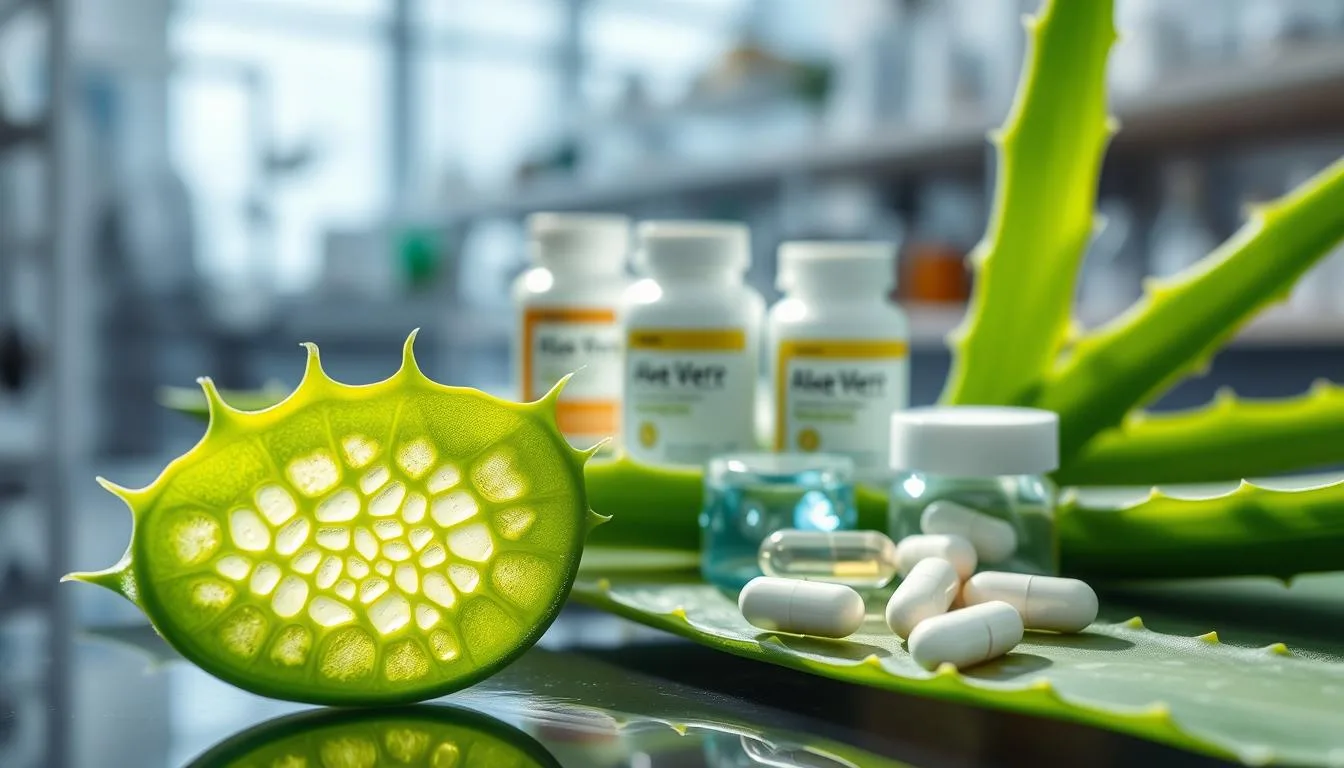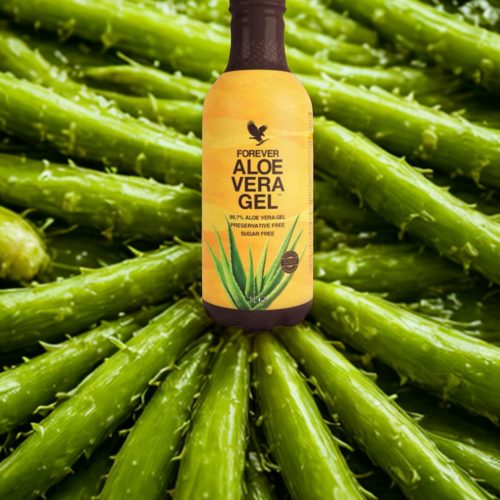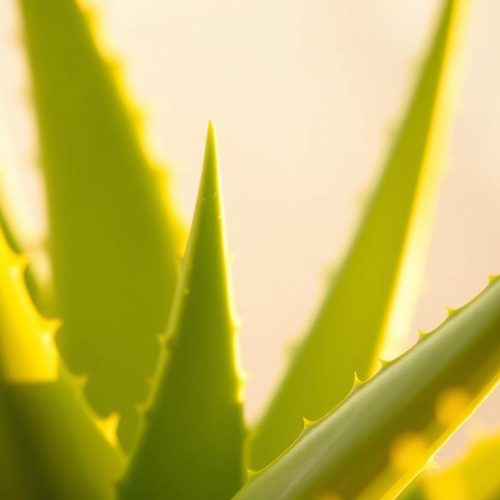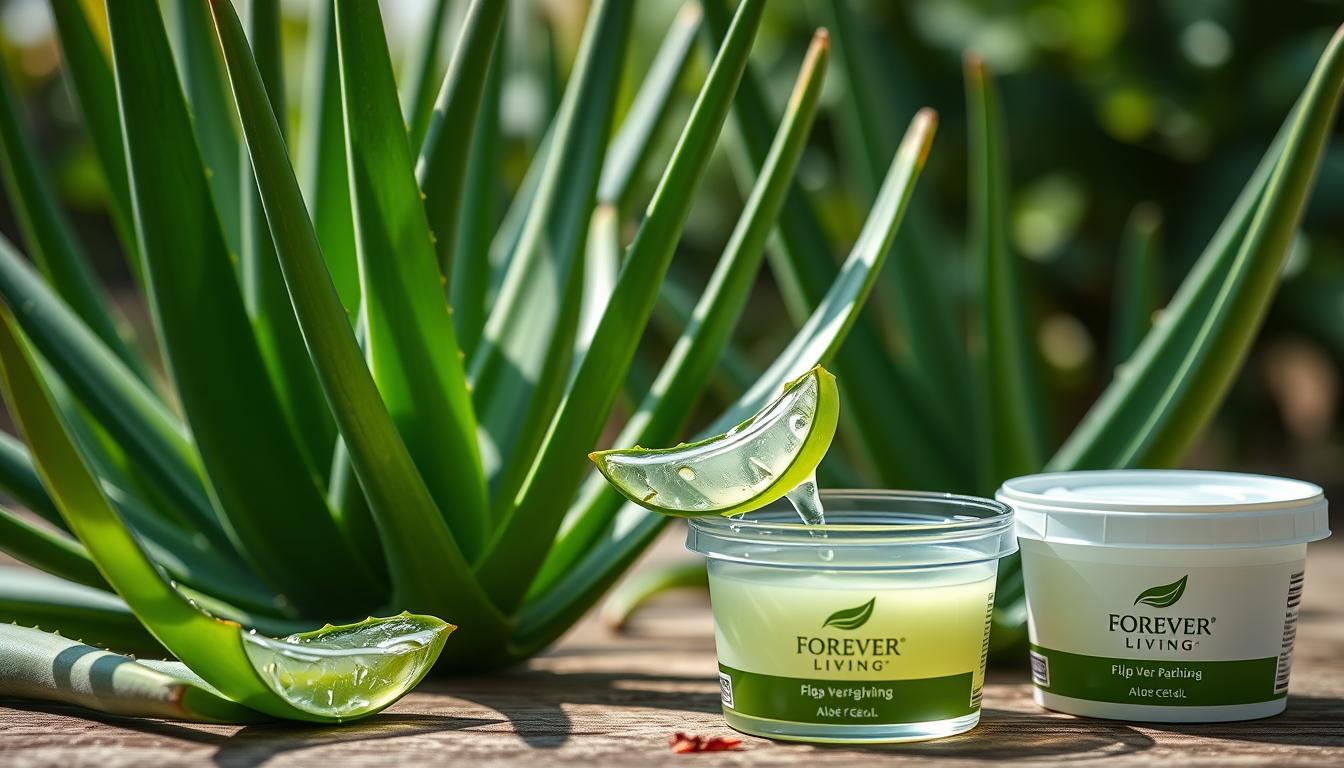Aloe vera has been a cornerstone in traditional medicine for centuries, revered for its healing properties and versatility. Its historical significance is undeniable, with ancient civilizations utilizing it for various medicinal purposes.
The transition of aloe vera into modern pharmaceutical applications marks a significant shift towards leveraging its bioactive compounds in drug delivery systems. This integration is revolutionizing the field, enabling the development of more effective and targeted therapies.
The role of aloe vera in controlled release mechanisms is particularly noteworthy, as it enhances the efficacy of treatments by ensuring a sustained release of active ingredients. This not only improves patient outcomes but also opens new avenues in pharmaceutical applications.
- The Ancient Healing Plant: Aloe Vera's Historical Significance
- From Traditional Medicine to Modern Pharmaceuticals
- Bioactive Compounds in Aloe Vera for Pharmaceutical Applications
- Aloe Vera Controlled Release Drug Delivery Systems: Core Mechanisms
- Formulation Techniques Using Aloe Vera Matrices
- Therapeutic Applications of Aloe-Based Drug Delivery
- Oral Drug Administration Using Aloe Vera Systems
- Current Research and Clinical Evidence
- Challenges in Developing Aloe Vera Drug Delivery Systems
- Future Prospects: The Evolution of Aloe Vera in Drug Development
- FAQ
- What are the traditional uses of aloe vera in medicine?
- What are the bioactive compounds in aloe vera?
- How does aloe vera work in controlled release drug delivery systems?
- What are the advantages of using aloe vera in drug delivery systems?
- What are the therapeutic applications of aloe-based drug delivery systems?
- How can aloe vera improve oral drug administration?
- What are the challenges in developing aloe vera drug delivery systems?
- What is the future of aloe vera in drug development?
- Are aloe vera drug delivery systems safe?
- How does aloe vera enhance wound healing?
- SHOP NOW FOR THE BEST ALOE PRODUCTS
- The Ancient Healing Plant: Aloe Vera's Historical Significance
- From Traditional Medicine to Modern Pharmaceuticals
- Bioactive Compounds in Aloe Vera for Pharmaceutical Applications
- Aloe Vera Controlled Release Drug Delivery Systems: Core Mechanisms
- Formulation Techniques Using Aloe Vera Matrices
- Therapeutic Applications of Aloe-Based Drug Delivery
- Oral Drug Administration Using Aloe Vera Systems
- Current Research and Clinical Evidence
- Challenges in Developing Aloe Vera Drug Delivery Systems
- Future Prospects: The Evolution of Aloe Vera in Drug Development
- FAQ
- What are the traditional uses of aloe vera in medicine?
- What are the bioactive compounds in aloe vera?
- How does aloe vera work in controlled release drug delivery systems?
- What are the advantages of using aloe vera in drug delivery systems?
- What are the therapeutic applications of aloe-based drug delivery systems?
- How can aloe vera improve oral drug administration?
- What are the challenges in developing aloe vera drug delivery systems?
- What is the future of aloe vera in drug development?
- Are aloe vera drug delivery systems safe?
- How does aloe vera enhance wound healing?
- SHOP NOW FOR THE BEST ALOE PRODUCTS
Key Takeaways
- Aloe vera’s historical use in traditional medicine has paved the way for its modern pharmaceutical applications.
- The bioactive compounds in aloe vera are being utilized in drug delivery systems for more targeted therapies.
- Controlled release mechanisms involving aloe vera are enhancing treatment efficacy.
- The integration of aloe vera into pharmaceuticals is unlocking new possibilities in drug development.
- Aloe vera’s role in modern medicine is expanding, driven by its versatility and therapeutic potential.
The Ancient Healing Plant: Aloe Vera's Historical Significance
The historical significance of aloe vera is profound, with its use in traditional applications dating back to ancient civilizations. This plant has been a cornerstone in the development of various traditional medicinal practices across different cultures.
Origins and Traditional Applications
Aloe vera’s origins are traced back to the African continent, specifically to the regions that are now Sudan, and it has been used for centuries in traditional medicine. The plant was highly valued for its gel-filled leaves, which were used to treat a variety of health issues, ranging from skin conditions to digestive problems.
In traditional applications, aloe vera was used topically to soothe skin irritations and promote wound healing. Its anti-inflammatory properties made it an effective remedy for burns, cuts, and other skin injuries. Internally, aloe vera was consumed to alleviate digestive issues, such as constipation and irritable bowel syndrome.
Documented Medicinal Uses Throughout History
Aloe vera’s medicinal uses have been well-documented throughout history. In ancient Egypt, it was used as a burial gift for pharaohs, signifying its importance. The Egyptians used aloe vera for its medicinal and cosmetic properties, applying it to treat various ailments.
In Ayurvedic medicine, aloe vera is considered a rasayana, or rejuvenating herb, believed to promote overall health and longevity. It is used to balance the body’s doshas, or energies, and is often incorporated into formulations aimed at enhancing vitality and well-being.
| Traditional Use | Description | Health Benefit |
|---|---|---|
| Topical Application | Used to soothe skin irritations and promote wound healing | Anti-inflammatory, promotes skin health |
| Internal Consumption | Consumed to alleviate digestive issues | Laxative properties, soothes digestive tract |
| Ayurvedic Medicine | Used as a rasayana to promote overall health and longevity | Balances body’s doshas, rejuvenating properties |
From Traditional Medicine to Modern Pharmaceuticals
Aloe vera’s journey from ancient traditional medicine to contemporary pharmaceuticals is a testament to its versatility and efficacy. This transition is largely attributed to the plant’s rich composition of bioactive compounds, which have been found to have significant therapeutic benefits.
Aloe Vera in Ayurvedic Medicine
Aloe vera has been a cornerstone in Ayurvedic medicine for centuries, used to treat a variety of ailments ranging from skin conditions to gastrointestinal issues. Its anti-inflammatory and antioxidant properties make it an ideal ingredient in traditional Ayurvedic formulations.
Applications in Homeopathic Treatments
In homeopathy, aloe vera is valued for its healing properties, particularly in treating digestive issues and skin conditions. Homeopathic preparations often utilize aloe vera in highly diluted forms to stimulate the body’s natural healing processes.
Integration into Allopathic Medicine
The integration of aloe vera into allopathic medicine has led to the development of various pharmaceutical products, including topical creams for wound healing and skin care, as well as oral supplements for digestive health. Research has validated the efficacy of aloe vera in enhancing the bioavailability of certain drugs and improving gastrointestinal health.
| Medical System | Aloe Vera Applications | Key Benefits |
|---|---|---|
| Ayurvedic Medicine | Skin conditions, gastrointestinal issues | Anti-inflammatory, antioxidant |
| Homeopathic Treatments | Digestive issues, skin conditions | Stimulates natural healing |
| Allopathic Medicine | Wound healing, skin care, oral health | Enhances bioavailability, improves gastrointestinal health |
The diverse applications of aloe vera across different medical systems underscore its potential in modern healthcare. As research continues to uncover the full spectrum of aloe vera’s benefits, its role in pharmaceutical development is likely to expand, offering new and innovative treatment options.
Bioactive Compounds in Aloe Vera for Pharmaceutical Applications
The pharmaceutical potential of aloe vera lies in its diverse array of bioactive compounds, which have been shown to have significant therapeutic benefits.
Aloe vera contains a range of bioactive compounds, including polysaccharides, antioxidants, and other therapeutic agents. These compounds have been extensively studied for their potential in various pharmaceutical applications.
Polysaccharides and Their Pharmaceutical Potential
Polysaccharides present in aloe vera, such as acemannan, have been shown to have immunomodulatory effects, enhancing the body’s immune response. These polysaccharides also contribute to the plant’s wound healing properties, making them valuable in pharmaceutical formulations.
The pharmaceutical potential of aloe vera polysaccharides extends to their ability to act as excipients in drug formulations, improving the stability and bioavailability of therapeutic agents.
Antioxidants and Anti-inflammatory Properties
Aloe vera is rich in antioxidants, including vitamins A, C, and E, which help protect against oxidative stress. The anti-inflammatory properties of aloe vera’s bioactive compounds make them suitable for treating various inflammatory conditions.
The antioxidants in aloe vera also contribute to its anti-aging properties, making it a popular ingredient in cosmetic and pharmaceutical products.
Other Therapeutic Compounds
In addition to polysaccharides and antioxidants, aloe vera contains other therapeutic compounds, including anthraquinones and flavonoids. These compounds have been shown to have analgesic and antimicrobial properties, further expanding the pharmaceutical potential of aloe vera.
The diverse range of bioactive compounds in aloe vera makes it a valuable resource for the development of novel pharmaceutical products.
Aloe Vera Controlled Release Drug Delivery Systems: Core Mechanisms
The integration of aloe vera into controlled release drug delivery systems offers a promising approach to enhancing therapeutic outcomes. This is achieved through the unique properties of aloe vera that allow for the controlled release of drugs, improving their efficacy and reducing potential side effects.
Definition and Working Principles
Controlled release drug delivery systems are designed to release drugs at a predetermined rate, ensuring that the drug concentration remains within the therapeutic window for a prolonged period. Aloe vera’s bioactive compounds play a crucial role in this process, acting as a matrix that releases the drug over time.
The working principle involves the use of aloe vera’s polysaccharides, which form a gel-like matrix that encapsulates the drug. This matrix then releases the drug through mechanisms such as diffusion, erosion, or degradation, depending on the formulation.
Advantages Over Conventional Drug Delivery Methods
Controlled release drug delivery systems using aloe vera have several advantages over conventional methods. These include improved bioavailability, reduced toxicity, and enhanced patient compliance due to the reduced frequency of dosing.
Moreover, aloe vera’s anti-inflammatory and antioxidant properties can complement the therapeutic effects of the drug, providing additional benefits.
Types of Controlled Release Systems Using Aloe Vera
There are various types of controlled release systems that utilize aloe vera, including hydrogels, nanoparticles, and microparticles. Each of these systems has its unique characteristics and applications.
| Type of System | Description | Application |
|---|---|---|
| Hydrogels | Cross-linked networks of aloe vera polysaccharides that can retain large amounts of water. | Used for wound healing and tissue engineering. |
| Nanoparticles | Small particles made from aloe vera that can encapsulate drugs for targeted delivery. | Used for cancer therapy and other diseases requiring targeted treatment. |
| Microparticles | Larger particles compared to nanoparticles, used for controlled release over a longer period. | Used for oral drug delivery and vaccine administration. |
Formulation Techniques Using Aloe Vera Matrices
Formulation techniques utilizing aloe vera matrices are revolutionizing the field of controlled release drug delivery. Aloe vera, known for its rich composition of bioactive compounds, offers a versatile platform for developing various drug delivery systems. The use of aloe vera matrices in formulation techniques has opened new avenues for improving drug efficacy and reducing side effects.
Aloe Vera Gels and Hydrogels
Aloe vera gels and hydrogels are widely used in drug delivery due to their biocompatibility and ability to retain large amounts of water. These matrices can be formulated to release drugs at a controlled rate, making them suitable for various therapeutic applications. The hydrophilic nature of aloe vera gels allows for sustained drug release, enhancing the therapeutic effect.
The preparation of aloe vera gels involves the cross-linking of aloe vera polysaccharides, which can be achieved through physical or chemical methods. This process results in a three-dimensional network that can encapsulate drugs, making it an effective matrix for controlled release formulations.
Nanoparticle and Microparticle Formulations
Nanoparticles and microparticles formulated using aloe vera matrices offer a promising approach for targeted drug delivery. The bioactive compounds in aloe vera enhance the stability and biocompatibility of these particles, making them suitable for various administration routes. These formulations can be designed to target specific tissues or cells, improving drug efficacy and minimizing side effects.
The preparation of aloe vera-based nanoparticles and microparticles involves techniques such as emulsion polymerization, spray drying, or ionic gelation. These methods allow for the encapsulation of drugs within the aloe vera matrix, resulting in controlled release profiles.
Hybrid and Composite Delivery Systems
Hybrid and composite delivery systems using aloe vera matrices represent a cutting-edge approach in drug delivery. These systems combine the benefits of different materials, such as synthetic polymers and natural biopolymers like aloe vera, to achieve optimal drug release profiles. The versatility of aloe vera allows it to be used in conjunction with other materials, enhancing the overall performance of the delivery system.
Hybrid systems can be designed to respond to specific stimuli, such as pH or temperature changes, allowing for tailored drug release. The use of aloe vera in these systems not only improves biocompatibility but also enhances the therapeutic potential of the formulation.
Therapeutic Applications of Aloe-Based Drug Delivery
Aloe-based drug delivery systems are revolutionizing the field of therapeutics by leveraging the natural healing properties of aloe vera. The versatility of aloe vera allows it to be used in a variety of therapeutic applications, ranging from skin conditions to complex diseases.
Dermatological Applications
Aloe vera has been widely recognized for its benefits in treating skin conditions due to its anti-inflammatory and antioxidant properties. Aloe vera gel is commonly used to soothe skin irritations, burns, and wounds. In drug delivery systems, aloe vera can enhance the topical delivery of drugs for conditions like acne, psoriasis, and eczema.

Wound Healing and Tissue Regeneration
The wound healing properties of aloe vera make it an ideal component in drug delivery systems aimed at treating chronic wounds. Aloe vera’s bioactive compounds promote tissue regeneration and enhance the healing process. Studies have shown that aloe vera can improve wound closure rates and reduce the risk of infection.
Cancer Therapeutics
Research has explored the potential of aloe vera in cancer therapeutics due to its bioactive compounds, which have shown promise in reducing tumor growth. Aloe vera can be used to develop targeted drug delivery systems that enhance the efficacy of cancer treatments while minimizing side effects.
Anti-Diabetic and Metabolic Disease Applications
Aloe vera has been investigated for its potential in managing diabetes and metabolic disorders. Its bioactive compounds may help regulate blood sugar levels and improve metabolic health. Aloe-based drug delivery systems could provide a natural adjunct therapy for managing these conditions.
Oral Drug Administration Using Aloe Vera Systems
Aloe vera systems are revolutionizing the way drugs are administered orally. The incorporation of aloe vera into oral drug delivery systems has shown significant promise in enhancing the bioavailability and controlled release of drugs.
Gastrointestinal Drug Delivery Mechanisms
The gastrointestinal tract is a complex system where drug absorption can be influenced by various factors, including pH, enzymatic activity, and the presence of food. Aloe vera’s bioactive compounds can modulate these factors to improve drug delivery.
The use of aloe vera in gastrointestinal drug delivery mechanisms involves its ability to enhance the solubility and permeability of drugs, thus improving their absorption.
Key benefits include:
- Enhanced drug solubility and permeability
- Modulation of gastrointestinal pH
- Protection of drugs from enzymatic degradation
Enhancing Bioavailability of Poorly Soluble Drugs
Many drugs are poorly soluble in water, which can limit their bioavailability when administered orally. Aloe vera’s bioactive compounds can enhance the solubility of these drugs, improving their absorption and bioavailability.
Studies have shown that aloe vera can increase the bioavailability of poorly soluble drugs by forming complexes that enhance their solubility.
Controlled Release Profiles in Oral Formulations
Controlled release drug delivery systems are designed to release drugs at a predetermined rate, improving their efficacy and reducing side effects. Aloe vera can be used to formulate controlled release matrices that provide a sustained release of drugs.
The use of aloe vera in controlled release oral formulations can lead to improved patient compliance and therapeutic outcomes.
- Aloe vera gels and hydrogels can be used to formulate controlled release matrices.
- Nanoparticle and microparticle formulations using aloe vera can provide sustained drug release.
Current Research and Clinical Evidence
Aloe vera’s role in modern pharmaceuticals is being redefined through current research and clinical evidence. The growing body of research is shedding light on the potential of aloe vera to enhance drug delivery systems, making them more effective and safer for patients.
Recent Breakthroughs in Aloe-Based Delivery
Recent breakthroughs in aloe-based delivery have shown significant promise in improving drug efficacy and reducing side effects. The use of aloe vera matrices in drug formulations has been particularly noteworthy, offering a natural and biocompatible approach to controlled release drug delivery.
Studies have demonstrated that aloe vera can be effectively used to create hydrogels and nanoparticles that can encapsulate drugs, improving their bioavailability and therapeutic index. This represents a significant advancement in the field, offering new possibilities for the treatment of various diseases.
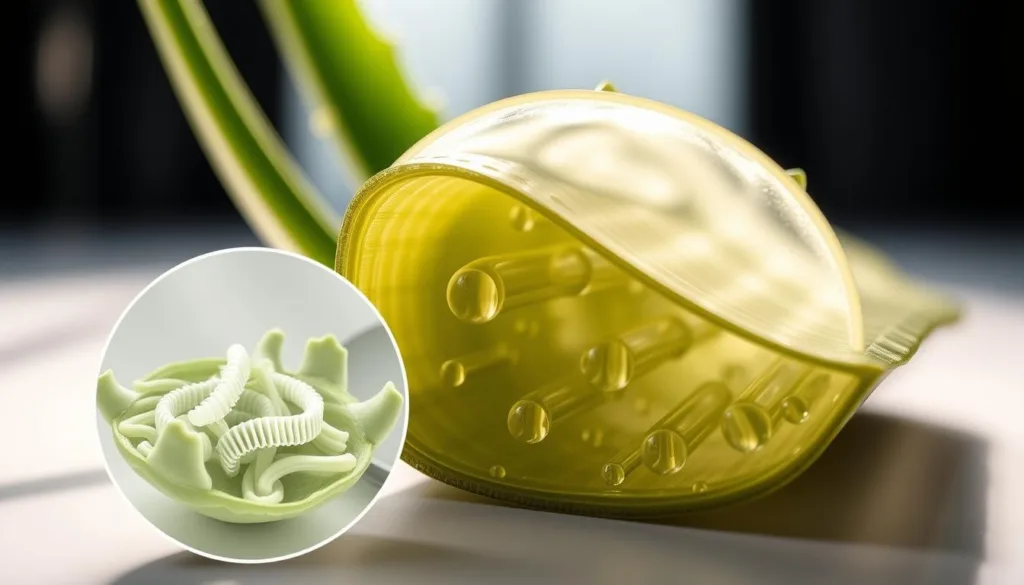
Clinical Trial Outcomes and Case Studies
Clinical trials have been conducted to evaluate the safety and efficacy of aloe vera drug delivery systems. The outcomes have been encouraging, with several case studies highlighting the benefits of using aloe vera in drug formulations.
For instance, a clinical trial involving patients with diabetes showed that aloe vera-based insulin delivery systems improved glycemic control and reduced the risk of hypoglycemia. Such findings underscore the potential of aloe vera to make a significant impact in the management of chronic diseases.
| Condition | Treatment | Outcome |
|---|---|---|
| Diabetes | Aloe vera-based insulin delivery | Improved glycemic control |
| Wound Healing | Aloe vera gel application | Faster healing rates |
| Skin Conditions | Aloe vera cream | Reduced inflammation |
Patient Response and Efficacy Data
Patient response to aloe vera drug delivery systems has been overwhelmingly positive, with efficacy data supporting its use in various therapeutic applications.
The biocompatibility and natural origin of aloe vera make it an attractive option for patients seeking alternative or complementary therapies. As research continues to uncover the full potential of aloe vera in drug delivery, it is likely that its use will become increasingly widespread.
Challenges in Developing Aloe Vera Drug Delivery Systems
The development of aloe vera drug delivery systems, while promising, faces several significant challenges that need to be addressed to unlock their full potential.
One of the primary issues is related to the inherent variability of aloe vera itself. The composition of aloe vera can vary significantly based on factors such as the plant’s source, growing conditions, and processing methods. This variability complicates efforts to standardize aloe vera-based products.
Standardization and Quality Control Issues
Standardization is crucial for ensuring the consistency and efficacy of drug delivery systems. However, achieving standardization with aloe vera is challenging due to its complex composition.
- Variability in Bioactive Compounds: The concentration of bioactive compounds in aloe vera can vary, affecting the overall efficacy of the drug delivery system.
- Quality Control Measures: Implementing stringent quality control measures is essential to ensure that aloe vera extracts meet the required standards for pharmaceutical applications.
Stability and Shelf-Life Concerns
Aloe vera’s stability and shelf-life are significant concerns in the development of drug delivery systems. The bioactive compounds in aloe vera can degrade over time, affecting the product’s potency and efficacy.
Factors Affecting Stability include temperature, light exposure, and moisture. Proper formulation and storage conditions are critical to maintaining the stability of aloe vera-based drug delivery systems.
Regulatory Hurdles and Compliance
Navigating regulatory requirements is a significant challenge in the development of aloe vera drug delivery systems. Regulatory bodies have strict guidelines regarding the safety, efficacy, and quality of pharmaceutical products.
- Compliance with Regulatory Standards: Manufacturers must comply with Good Manufacturing Practices (GMP) and other regulatory standards to ensure product quality.
- Documentation and Testing: Extensive documentation and testing are required to demonstrate the safety and efficacy of aloe vera drug delivery systems.
Manufacturing Scalability and Cost Factors
Scaling up the production of aloe vera drug delivery systems while maintaining quality and reducing costs is a significant challenge. The cost of raw materials, processing, and quality control measures can be substantial.
Efficient manufacturing processes and cost-effective sourcing of high-quality aloe vera are essential for making these drug delivery systems commercially viable.
Future Prospects: The Evolution of Aloe Vera in Drug Development
The future of aloe vera in drug development is promising, with ongoing research expected to unlock new applications in pharmaceuticals. As the field continues to evolve, aloe vera is likely to play a significant role in improving the treatment of various diseases and conditions.
Aloe vera’s unique properties make it an attractive candidate for controlled release drug delivery systems. Its bioactive compounds have shown potential in enhancing the bioavailability of poorly soluble drugs and providing sustained release profiles. The evolution of aloe vera-based drug delivery systems is expected to lead to innovative treatments for a range of health issues.
Future studies will likely focus on optimizing the formulation techniques using aloe vera matrices, exploring new therapeutic applications, and addressing the challenges associated with standardization and regulatory compliance. As research progresses, the potential for aloe vera to make a significant impact on drug development is substantial, offering new opportunities for the treatment of various medical conditions.
FAQ
What are the traditional uses of aloe vera in medicine?
Aloe vera has been used for centuries in traditional medicine, including Ayurvedic, homoeopathic, and Allopathic medicine, to treat various skin conditions, wounds, and digestive issues.
What are the bioactive compounds in aloe vera?
Aloe vera contains a range of bioactive compounds, including polysaccharides, antioxidants, and other therapeutic compounds, which have anti-inflammatory, antioxidant, and wound healing properties.
How does aloe vera work in controlled release drug delivery systems?
Aloe vera’s bioactive compounds create a matrix that releases drugs at a controlled rate, improving efficacy and reducing side effects.
What are the advantages of using aloe vera in drug delivery systems?
Aloe vera drug delivery systems offer improved bioavailability, reduced toxicity, and enhanced efficacy compared to conventional drug delivery methods.
What are the therapeutic applications of aloe-based drug delivery systems?
Aloe-based drug delivery systems have a range of therapeutic applications, including dermatological applications, wound healing, cancer therapeutics, and anti-diabetic and metabolic disease applications.
How can aloe vera improve oral drug administration?
Aloe vera systems can enhance bioavailability and improve controlled release profiles for oral formulations, particularly for poorly soluble drugs.
What are the challenges in developing aloe vera drug delivery systems?
Challenges include standardization and quality control issues, stability and shelf-life concerns, regulatory hurdles, and manufacturing scalability and cost factors.
What is the future of aloe vera in drug development?
Ongoing research is expected to further improve the use of aloe vera in drug delivery systems, with potential new and innovative applications in pharmaceuticals.
Are aloe vera drug delivery systems safe?
Clinical trials have demonstrated the safety and efficacy of aloe vera drug delivery systems, with positive patient response and efficacy data.
How does aloe vera enhance wound healing?
Aloe vera’s bioactive compounds, including polysaccharides and antioxidants, promote wound healing by enhancing tissue regeneration and reducing inflammation.
